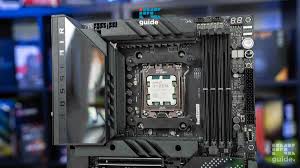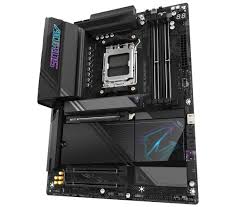The motherboard is the central printed circuit board (PCB) in a computer system, often referred to as the mainboard or system board. It serves as the primary foundation that connects and allows communication among all the essential hardware components, including the central processing unit (CPU), memory modules, storage devices, graphics cards, and various input/output (I/O) peripherals. In 2025, the motherboard market has seen significant advancements, and choosing the right one is crucial for a high-performance and stable computer system.
Key Considerations When Choosing a Best Motherboard

| Feature | Importance | Benefit |
|---|---|---|
| CPU Compatibility | Ensures the motherboard works with your processor | Make sure the motherboard supports your desired CPU model (Intel or AMD) |
| Chipset | Defines features and capabilities | Chipset determines the number of PCIe lanes, memory speeds, and overclocking features |
| RAM Support | Affects memory capacity and performance | Ensure compatibility with the desired memory type (DDR4/DDR5) and speed |
| PCIe Slots | Affects expansion options | Multiple PCIe slots allow for adding GPUs, sound cards, and other expansion cards |
| Connectivity | Defines the ability to connect peripherals | Look for USB ports, Wi-Fi support, Bluetooth, and Ethernet options |
Compatibility with CPU
- CPU Socket Types: Different CPU models from Intel and AMD have specific socket types. For Intel, the LGA 1700 socket is used for 12th and 13th – generation Core processors 📌. For example, the Intel Core i9 – 12900K requires an LGA 1700 socket motherboard. On the AMD side, the AM5 socket is designed for the latest Ryzen 7000 – series processors. Ryzen 7000 – series CPUs cannot be used with AM4 – socket motherboards due to different pin configurations.
- Chipset Compatibility: The chipset on a motherboard plays a vital role in facilitating communication between the CPU and other components. For Intel, the Z – series chipsets (e.g., Z690 and Z790) are high – end options, typically paired with high – performance Intel Core i7 and i9 CPUs, and support overclocking 🛠️. In contrast, the H – series chipset (e.g., H610) is more budget – friendly and suitable for entry – level and mid – range CPUs. For AMD, the X670E and X670 chipsets are top – of – the – line for Ryzen 7000 – series CPUs, offering features like high – speed PCI – Express 5.0 connectivity and enhanced memory overclocking capabilities, while the B650 – chipset motherboard is more aimed at mainstream users.
Memory Support

- Memory Types (DDR4, DDR5): DDR4 and DDR5 are the two main types of memory currently available. DDR5 offers several advantages over DDR4, such as higher frequency (starting at 4800MHz compared to DDR4’s 2133MHz typically), larger bandwidth, and better power – efficiency (1.1V operating voltage compared to DDR4’s 1.2V) 🌟. However, DDR5 memory modules are generally more expensive, and DDR4 is still popular due to its lower cost and wide availability.
- Maximum Memory Capacity and Speed: High – end motherboards often support larger memory capacities and higher – speed memory modules 💾. Some high – end motherboards can support up to 128GB or even 256GB of DDR5 memory, which is useful for professionals working with large datasets. High – performance motherboards can support memory modules with high clock speeds, and faster memory speeds can improve overall system performance, especially in applications sensitive to memory latency.
Expansion Slots
- PCI – Express Slots: PCI – Express (PCIe) slots are important for connecting high – performance components like graphics cards, high – speed network cards, and storage expansion cards 🚀. PCIe slots come in different generations, with each generation offering increased bandwidth. PCIe 4.0 offers double the bandwidth of PCIe 3.0, and PCIe 5.0 is the latest generation, expected to be crucial for future – proofing systems as technologies evolve.
- Other Expansion Slots (PCI, M.2, etc.): Motherboards may also have traditional PCI slots for connecting legacy devices, although their usage has declined 🎙️. M.2 slots are increasingly important for high – speed storage, with M.2 SSDs offering much faster read and write speeds compared to traditional 2.5 – inch SATA SSDs. Some high – end motherboards may feature U.2 slots, mainly used for enterprise – level storage devices with higher data transfer rates.
Storage Interfaces
- SATA Ports: Serial ATA (SATA) ports are common for connecting traditional hard disk drives (HDDs) and SATA – based solid – state drives (SSDs) 💽. Most motherboards come with at least 4 – 6 SATA ports, and SATA III offers a maximum data transfer rate of 6Gbps, which is sufficient for many everyday tasks but can be a bottleneck for high – performance storage needs.
- M.2 and U.2 Slots: M.2 slots offer significant storage speed advantages, with PCIe – based M.2 SSDs reaching speeds of up to 7000 – 10000MB/s in sequential read and write operations 🚀. U.2 slots, although less common in consumer – grade motherboards, are designed for enterprise – level storage, providing even better performance in some scenarios.
Power Delivery and VRM
- Importance of Stable Power: Stable power delivery is crucial for the proper functioning of a motherboard and all components. An unstable power supply can lead to issues like CPU throttling or hardware failures. Components like high – performance CPUs and graphics cards require a consistent and clean power supply to operate at their best ⚡.
- VRM Components and Phases: The voltage regulator module (VRM) on a motherboard consists of components like MOSFETs, inductors, and capacitors 🔌. A higher number of phases in a VRM can provide a more stable power supply, especially for high – power – consuming components. For example, a high – end CPU like the AMD Ryzen 9 7950X benefits from a motherboard with a multi – phase VRM.
Types of Motherboards
ATX Motherboards
- Physical Dimensions and Layout: Advanced Technology Extended (ATX) motherboards are the most common type in the desktop computer market, with a standard size of 305 x 244 mm (12 x 9.6 inches) 📏. The CPU socket is typically near the center for efficient heat dissipation, and memory slots are close to the CPU socket for faster data transfer. They feature multiple PCI – Express (PCIe) slots, including PCIe x16 slots for high – performance graphics cards, and several PCIe x1 slots for other expansion cards.
- Features and Advantages: ATX motherboards offer high expandability, supporting multiple graphics cards for high – end gaming or professional workstations 🌟. They also support a large number of storage devices with multiple SATA ports and M.2 slots. In terms of power delivery, they often have robust voltage regulator modules (VRMs) for handling high – performance CPUs, especially useful for overclocking.
Micro – ATX Motherboards
- Size Comparison with ATX: Micro – ATX motherboards are a more compact alternative, with a size of 244 x 244 mm (9.6 x 9.6 inches), approximately 25% smaller in length compared to ATX motherboards 📏. They have a more square – shaped appearance and a more compact layout with fewer expansion slots but still maintain compatibility with many components.
- Suitability for Smaller Builds: Micro – ATX motherboards are well – suited for smaller computer builds like small – form – factor (SFF) PCs. They can fit into smaller cases, are more portable, and take up less space 🖥️. They typically have 4 memory slots, at least one PCIe x16 slot for a graphics card, and 4 – 6 SATA ports for storage. They are also a more budget – friendly option in some cases.
Mini – ITX Motherboards

- Compact Design: Mini – ITX motherboards are the smallest of the commonly used motherboard form factors, with a size of just 170 x 170 mm (6.7 x 6.7 inches) 📏. Components are arranged in a tight and efficient manner, reducing the length of electrical traces and potentially improving signal integrity and power efficiency.
- Use Cases (Mini PCs, HTPCs): Mini – ITX motherboards are primarily used in applications where space is at a premium, such as mini PCs for basic computing tasks or industrial applications, and home theater PCs (HTPCs) for media streaming 🎬. However, they have limited expandability compared to ATX and Micro – ATX motherboards.
Best Motherboards in Different Categories
Best High – End Motherboards
| Motherboard Model | Chipset | Key Features | Price Range |
|---|---|---|---|
| ASUS ROG Maximus Z790 Hero | Z790 | 20 + 1 – phase power delivery system with 90A power stages, two PCI – Express 5.0 x16 slots, one PCI – Express 4.0 x16 slot, 5 M.2 slots (one supporting PCIe 5.0 x4), comprehensive cooling system | Premium ($350+) |
| MSI MEG Z790 GODLIKE | Z790 | 26 + 2 – phase Duet Rail power system, supports 13th – generation Intel Core processors, high – speed DDR5 memory up to 128GB and overclocking to DDR5 – 7800+ (OC), latest ALC4082 audio processor with ESS audio DAC and amplifier, 10G LAN port and Wi-Fi 6E | High – end ($300 – $350) |
Best Mid – Range Motherboards
| Motherboard Model | Chipset | Key Features | Price Range |
|---|---|---|---|
| Gigabyte B760M AORUS ELITE AX | B760 | Stable power delivery system, can handle mid – range CPUs like Intel Core i5 – 13600K, Wi-Fi 6E support | Mid – range ($200 – $250) |
| ASRock B760M Pro RS | B760 | Rich set of interfaces (multiple USB ports, HDMI and DisplayPort), reliable power delivery system, supports 12th, 13th, and 14th – generation Intel Core processors, user – friendly BIOS interface | Mid – range ($250 – $300) |
Best Budget Motherboards
| Motherboard Model | Chipset | Key Features | Price Range |
|---|---|---|---|
| Biostar H610MHD Pro | H610 | Low price, can handle entry – level CPUs like Intel Core i3 – 12100, SATA ports for storage, basic expansion slots, stable operation | Budget ($100 – $150) |
| Colorful CVN B760M GAMING FROZEN V20 | B760 | Basic expansion interfaces (PCI – Express x16 slot, multiple SATA ports, M.2 slot), simple and easy – to – use BIOS interface, basic audio and network capabilities | Budget ($100 – $150) |
User Reviews and Ratings
Gathering User Feedback
User reviews and ratings are essential for providing a comprehensive view of motherboards. E – commerce platforms like Amazon, Newegg, and Best Buy allow customers to leave detailed reviews and ratings. Professional hardware forums like Tom’s Hardware Forum, Reddit’s r/buildapc, and Overclock net are also valuable resources. When considering reviews, the number of reviews, the consistency of the feedback, and cross – referencing information from multiple sources are important to ensure authenticity and objectivity 📋.
Analyzing Common Praises and Complaints
High – end motherboards are often praised for their excellent performance, powerful power delivery systems, and rich features like PCI – Express 5.0 support. Mid – range motherboards are commended for their cost – effectiveness and stability. However, common complaints include BIOS – related problems such as difficult navigation, update failures, and compatibility issues. Some users also complain about the lack of sufficient ports or expansion slots, especially in budget motherboards where the quality of components may be lower.
Future Trends in Motherboard Technology
Next – Generation PCIe Standards (e.g., PCIe 6.0)

PCIe 6.0 is set to double the data transfer rate per lane compared to PCIe 5.0, with a data rate of 64 GT/s. This will enable even faster data access for high – speed storage devices, potentially reducing the time to load large files, boot the operating system, and transfer data. Graphics cards will also benefit from the increased bandwidth, allowing for smoother gameplay, more detailed graphics, and faster rendering times in graphics – intensive applications 🚀.
Advances in Memory Technology
DDR5 memory is expected to see further improvements in frequency and capacity. Currently available with frequencies starting at 4800MHz, future generations may reach 8000MHz or more. Memory capacity may also increase beyond the current 128GB per module, which will be beneficial for professionals working with large datasets in applications like artificial intelligence, data analytics, and 3D animation 📈.
Integration of AI – related Features
Motherboards are starting to integrate AI – related features. AI – powered power management systems can analyze the power requirements of components in real – time and adjust power delivery, saving energy and reducing heat generation. AI – enabled hardware monitoring can detect potential hardware issues before they become serious problems, improving system stability and reliability 🤖.
Recap of Key Points
Compatibility with the CPU, memory support, expansion slots, storage interfaces, and power delivery are crucial factors when choosing a motherboard. Different types of motherboards (ATX, Micro – ATX, Mini – ITX) offer varying levels of expandability and are suitable for different use cases. High – end, mid – range, and budget motherboards each have their own features and target different user groups.
Final Advice for Choosing the Best Motherboard
Assess your needs first. Gamers and content creators may need high – end motherboards, while casual users can get by with mid – range or budget motherboards. Consider your budget as well, as high – end motherboards come at a higher cost, and finding the right balance between performance and price is key. The motherboard is the heart of your computer system, and investing in a high – quality one can ensure long – term performance, stability, and upgradeability.
